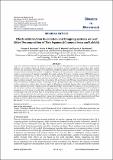Effects of Rhizobium Inoculation and Cropping systems on Leaf Litter Decomposition of Two legumes (Common bean and Lablab)

View/
Date
2018-03Author
Massawe, Prosper
Mtei, Kelvin
Munishi, Linus
Ndakidemi, Patrick
Metadata
Show full item recordAbstract
Crop litter residues decompose and provide nutrients in to the soil. Decomposition is a process which is accelerated by
sufficient soil conditions (good soil physical properties, soil moisture and microorganisms) and residues litter quality.
However, the quantitative knowledge on decomposition of different legumes under such conditions when litter residues
are placed above and below (10 cm) soil is insufficient. Therefore, the decomposition study of the two inoculated legumes
residues, common bean (P. vulgaris) and lablab (D. lablab) collected from two cropping seasons (2015-2016) was set
using litterbag experiments at the screen house of Selian Agricultural Research Institute (SARI). The residues were
applied on the surface and on sub soils and then retrieved after 10, 20 and 30 days. The parameters determined from the
legume residues included; mass loss, decay rate constant (k), and Carbon and Nitrogen concentrations. Results showed
lower decomposition of legume residues collected from two cropping seasons when the litterbags were placed on the soil
surface compared to subsoil. Mass loss was higher in Rhizobium inoculated legumes than uninoculated legumes of
residues collected from both cropping seasons. D. lablab had higher mass loss than P. vulgaris on the soil surface and in
sub soil of litter residues collected from both cropping seasons. The residues decay rate ranged from 0.97 to 0.99 for all
treatments in screen house across the litter residues collected from the two cropping seasons. Lablab recorded the high
decomposition rate than common bean in all sampling times as a result of high initial N and C content in the litter
residues. This predicts that, the mass loss, nutrient content, and litter quality were all changed mostly in the first 0-30
days, which indicates that early stage of litter residues incorporation is important in nutrients release into the soil. These
findings showed the effect of plant residues on the supply of mineral N to crops growing during subsequent seasons.
